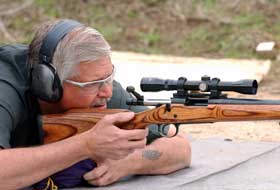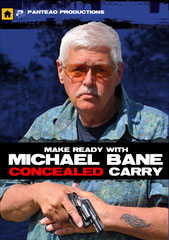...it didn't snow yesterday! I guess we have to take our small victories where we find them. I've been playing catch-up this week, whipping out my column in
The Cowboy Chronicle, finishing up the bullet point outline for THE BEST DEFENSE segments on concealed carry (which I also want to tun into a stand-along 90
minute video package) and working on the basics of a new production company I'm setting up.
I of course spent yesterday afternoon in breathless fear for the kid in the balloon, although I apparently misheard the breathless announcer and thought the balloon held all 8 kids from that wretched reality show
"Moron & Bimbo Plus 8!" Had that been the case, I was hoping the balloon would be blown to
Somewhereistan where all 8 little
wretchettes would be adopted by a peasant farm family and forced to pull a plow for the next decade. Now, that would be a reality show I could get into!
Here's the skinny on the Bushmaster/Remington ACR civilian version, from Adam Heggenstaller at the
SI Guns & Hunting blog.
The ACR, or Adaptive Combat Rifle, has been an ongoing collaboration involving Bushmaster, Magpul and Remington for the past two years. A quick rundown of features includes: a two-position (suppressed and non-suppressed), short-stroke, gas-piston system of operation; modular, interchangeable bolt heads, barrels, magazines, buttstocks (one of which is a six-position side-folder) and handguards; an aluminum upper receiver and a polymer lower receiver; a cold hammer-forged, free-floating barrel; and ambidexterous controls. In short, it's innovative and badass.
From a consumer viewpoint, unless you just like current military hardware and wanna be firstest with the bestest, it's hard to rationalize the higher price tags (most above MSRP) that are going to be attached to the next-gen black rifles. No doubt they'll be coming down as the pipeline fills up.
My friend Caleb over
Gun Nuts Media has an interesting take on point shooting:
Have you ever seen the sights on a pistol from the 1930s? They barely even exist on a lot of guns. The sights on a military issue 1911 from back then were among the best sights in the game, and they’re not even close to what I’d consider an adequate sighting system. So it actually makes sense that for close range combat shooting you’d adopt a school of thought that taking the time to acquire the itty-bitty-teensy-weensy sights isn’t really worth the effort, because the sights were just awful.
The issue of course is that times have changed, and we have modern, quality sight systems for handguns that allow the shooter to rapidly pick up the sights and place accurate hits on target just as fast as someone using a point shooting method of looking over the gun. Teaching the flash sight picture isn’t even that difficult for most people, especially if you’re using a gun set up with Express sights.
I don't necessarily agree with this viewpoint, although it has its merits. I think "point shooting," that is, non-visual body index shooting (okay, so that's my definition) works perfectly within context, which is close-in reactive shooting. It works because
monkeys can point real good! You can try it yourself right now at home! Stop reading, pick something in your environment — say, a wall switch — and point at it. I'll bet that 99.99% of you were able to successfully point at the object. Wow!
Back when I was cave diving, my primary instructor used to say, "Never train against the operating system." What that means is as primates we're wired a certain way, and while yes indeedy there are people who juggle running chain saws for a living, I'm willing to bet you (and certainly not me!) are not one of them. So when we rigged out cave diving gear, we tried to make sure the rigging accommodated primate reactions like the flinch. When startled or scared, monkeys flinch — they crouch, pull their hands up and in to protect their heads and eyes and get the chemical "flee or fight" injection...and so do you. Here's a "dummy" example of rigging to accommodate primate response — on deep wrecks I carried multiple knives and rescue tools, but I always had a net-ripper knife bungied to the left front harness strap and a rescue knife on the right front harness strap. When I got tangled up in old fishing netting invariably found on a wreck, I was a scared little monkey...but my post-flinch hands rested on the tools necessary to extricate myself.
One other hard-wired primate function is
look at the threat! We have the forward facing binocular vision common to predators, and that type of vision comes with software that drives us to fix our focus on the prey/threat. The closer the threat is, the more our visual focus zooms in on the threat. That's why lasers like Crimson Trace work so well...if we're hard-wired to focus on the threat, it's handy to have a red dot to show where the bullet will go regardless of where the gun is. Here's how the late Col. Rex Applegate described it in
Bullseyes Don't Shoot Back:
Point shooting relies on the body's instinctive ability to point at nearby objects with reasonable accuracy...It is so natural and so well engrained that it is not greatly affected even when the body is suffering reactions from extreme stress...
Again, I believe point shooting is limited (as, indeed, are all tools). But I have proven to my own satisfaction that I can reliably hit a close-up target from a retention position and/or from any point on the drawstroke as the gun is driven out and upwards toward eye-level.
Shooting is, I believe, a continuum, a series of different skills lumped together under the one terminology. It runs roughly from body-indexed point shooting (which is by any definition "aimed" fire) to target-focused shooting with the sights (what an IPSC shooter means by looking "through" the sights...this can also be defined as a "flash sight picture") to more traditional aimed fire, with a sight picture appropriate for the distance to the target. Rob Leatham can get a flash sight picture at a 50-yard popper...I can't. I need the hard sight picture.






















